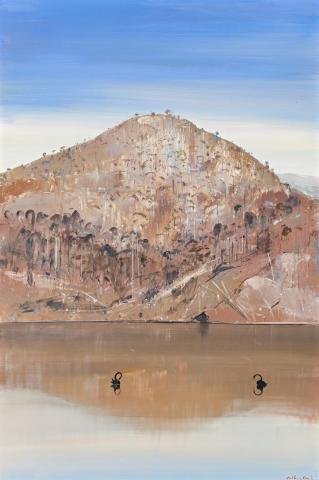REFLECTED HILL, SHOALHAVEN, 1976
ARTHUR BOYD
oil on composition board
91.0 x 61.0 cm
signed lower right: Arthur Boyd
inscribed verso: Round Hill River / and Swans / 22
Blue Boy Gallery, Melbourne
Private collection, United States of America
Deutscher~Menzies, Melbourne, 23 August 1999, lot 94 (as 'Round Hill River and Swans, Shoalhaven')
Gould Galleries, Sydney (label attached verso)
Private collection, Sydney
Reflected Hill, Shoalhaven, 1976 is among the earliest and finest evocations of the Shoalhaven riverbanks to be depicted by Arthur Boyd and was produced at the time of the iconic series of river landscapes he painted on copper between the years 1974 and 1976. It closely relates to Reflected Hill in Sunlight and Cleft Rock, 1974-76 providing us with a more distant view of the rounded hill near Boyd's first residence on the Shoalhaven River, Riversdale, which he purchased in 1974.1 Boyd also referred to this hill as Riversdale Hill and made the comment that 'As Pulpit Rock is to Bundanon, this hill is to Riversdale 'dominant, protective.'2 He often returned to this subject at many different times of the day showing the soft pink/gold sunlight as it touched the face of the hillside and reflected in the still waters below. During this period Boyd's reflections are tranquil and delicately formed using subtle washes of oil paint to evoke a sense of peace and solitude in nature. Two black swans drift across the water adding to the serenity of the scene. The oft-depicted cleft rock on the riverbank guides the eye through the composition and into the landscape itself through a series of fallen trees, their trunks white with weathering. Like Whiteley during this same period, Boyd found something sensual in the landscape and in particular in these rock hollows along the river bank. He writes, 'The clefts in the Shoalhaven River have a meaning to me apart from their geological grandeur. At times they seem quite erotic and explicitly anatomically sexual.'3
Boyd's move to the Shoalhaven marked a significant turning point in his oeuvre. While he did not completely cast out the figurative from his work during the twenty year period at Riversdale and later Bundanon, the darker allegorical scenes painted from history and, more often the bible, are no longer present in his work. A new found peace and calm pervaded his life and this was resolutely echoed through these early views of the Shoalhaven River in particular.
1. McGrath, S., The Artist and the River: Arthur Boyd and the Shoalhaven, Bay Books, Sydney, 1982, p. 106 (illus.)
2. Ibid, p. 218
3. Ibid, p. 182 1
